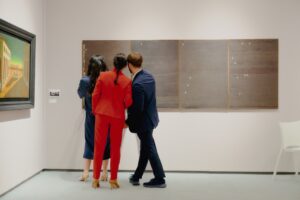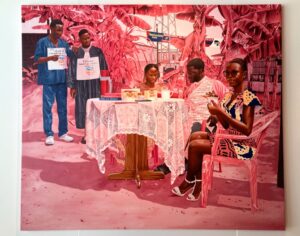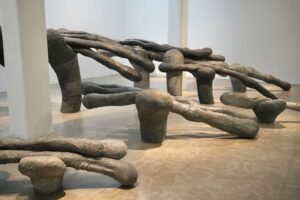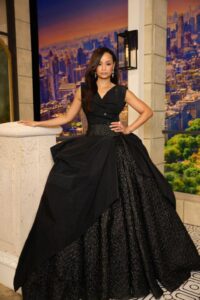Hong Kong’s Kiang Malingue Gallery Expands to New York, With the Aim of Fostering Dialogues

Kiang Malingue, one of Hong Kong’s most prominent galleries, will open a new commercial space in New York’s Chinatown neighborhood this week.
Known for a program that equally nurtures emerging talents and represents some of most acclaimed artists from Asia, Kiang Malingue has established itself in the past 15 years as a gallery to watch. Among the artists on its roster are two artists who have previously done national pavilions at the Venice Biennale, Ellen Pau (Hong Kong in 2001) and Ho Tzu Nyen (Singapore in 2011), as well as US-based artists Homer Shew, Brook Hsu, and Kyung-Me.
Its founders, Edouard Malingue and Lorraine Kiang, said the move to New York is part of a strategy that includes tapping into a growing community of young Asian American collectors and an increasing market interest in Asian and Asian diaspora artists.
“After years of running the gallery in Hong Kong, we wanted to have a foot in the West to continue promoting the program and to create more dialogue between the West and where we are in Hong Kong now,” Malingue told ARTnews.
Added Kiang, “The program was always meant to grow and develop. Opening in New York gives us the opportunity to see how it can evolve elsewhere.”
The gallery, too, has matured alongside growing interest in understanding Asian artists and Asian art. Two decades ago, institutions and scholars only scratched the surface, whereas today, audiences want to go deeper. Kiang Malingue wants to serve as one venue for that to occur as “there aren’t enough galleries that truly spend the time to delve into this subject matter,” Kiang said.

Located at 50 Eldridge Street, the space’s inaugural exhibition will present new work by Japanese artist Hiroka Yamashita, marking her New York solo debut. The show is also a homecoming of sorts as Yamashita received her MFA from Rutgers University in 2019 and hasn’t been back to the city since. “It’s an exciting return to New York for her—she knows the city well,” Kiang said.
Chinese galleries have been steadily expanding their presence in New York in the past few years, mirroring a broader migration trend as more wealthy Chinese individuals move to the United States. In 2023, Alisan Fine Arts, a long-established Hong Kong gallery known for championing Chinese modern masters and contemporary ink paintings, opened a location on the Upper East Side. Earlier this year, Shanghai-based gallery Bank, which represents some of China’s most buzzed-about ultra-contemporary artists like Sun Yitian and Liang Hao, launched its own outpost in the city.
Recognizing the potential to connect with those high-net-worth individuals as well as members of the Asian diaspora seeking to reconnect with their cultural roots, Kiang said the gallery hopes to foster a sense of community. “It’s just like Asians wanting to have Asian food in New York,” she said, noting that the collectors they’ve already met in the city are eager to learn more when they talk about artists from Hong Kong, Greater China, and the Southeast Asia. “There’s a kind of familiarity—whether it’s in the language or in what the artist is doing.”
Even still, Malingue hopes all will come to the gallery to learn about its program. “I believe a gallery’s role is to bring people together—to create a place where people can meet and discover things they didn’t expect,” he said.
In its first year in New York, Kiang Malingue plans to mount three to four exhibitions, before refining their approach for the following year. While some of the programming in New York will be drawn from Hong Kong, the aim is to also develop exhibitions that connect the two spaces and for the New York outpost to be rooted in its local context.
“It’s really like two trees,” said Kiang. “One that’s deeply rooted in Hong Kong, and a young one we’re planting in New York.”

A Hong Kong gallery opening in the US at this moment, when the global art market is contracting and geopolitical tensions between the US and China are at a historic high, exacerbated by a tariff war, might seem like an odd choice. (The Trump administration’s sweeping 145 percent tariff on imports from China, now also applies to Hong Kong.) When asked about the impact of the tariffs, especially when several Chinese galleries have pulled back even showing at US art fairs, Malingue said his gallery’s operations haven’t yet disrupted, but he acknowledged the challenges ahead.
“It’s super tough, but it’s never been more vital to have a dialogue between New York and Hong Kong,” Malingue said. “When things become tough, that’s when you need to engage with the public, because sales don’t happen with the snap of a finger. We have to explain what the artist is about.”
The gallery has long championed multimedia practices, particularly video, which are less affected by tariffs. In September, it will present a video-based exhibition by Chinese artist Zheng Bo, the first of many such shows in the medium. However, Kiang emphasized that the gallery remains committed to showcasing work across all mediums, ranging from painting to installation, and will not pivot solely to video art because of the ongoing tariff dispute. Another strategy, Malingue noted, could be that the gallery launch a residency program to invite artists to live and create in New York for extended periods if tariffs on Hong Kong artists become prohibitively high.
Despite the current state of US-China relations, Malingue said institutional interest stateside hasn’t waned. “I want to insist on the fact that US institutions are still extremely engaged with what’s happening around the world,” he said. “They remain open, curious, supportive.”
While launching a new space during a market downturn might seem counterintuitive, many art market experts believe it’s actually one of the best times to expand. Kiang shares this optimism, noting that the timing could work in their favor. As speculative buying slows, she said, collectors often turn their attention away from the blue-chip or the market darling toward emerging artists with experimental or conceptual practices, whose works typically fall into lower price brackets.
This trend is backed by the latest UBS Art Basel Market Report, which found that while global art sales declined by 12 percent, the segment for works priced under $50,000 grew in both value and volume in 2024. That describes much of Kiang Malingue’s roster, with prices ranging from $5,000 to $300,000. “You can only be a gallerist if you’re idealistic,” said Malingue. “You have to believe that people will come together—and when you present an artist from the Asian diaspora, you have to believe that it won’t just resonate with the diaspora community. The work can touch the soul and curiosity of a much broader audience.”






